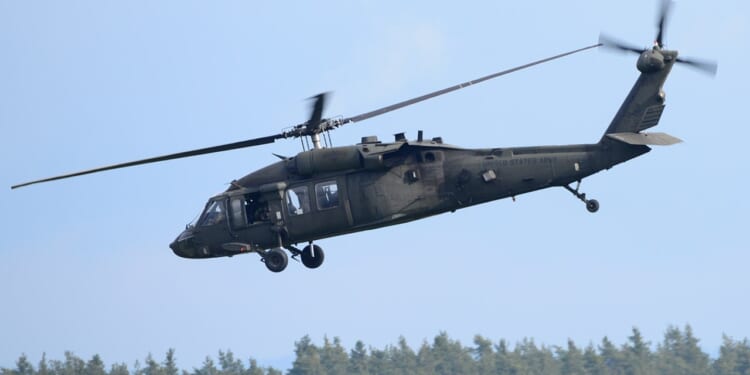The ongoing Ukraine War has shown the limits of helicopters, particularly in comparison to drones that can carry out many of the same functions at a lower cost.
The United States Army is scaling back its helicopter procurement and development plans—effectively halting (or, at least redirecting) some purchases and programs. This represents a strategic shift, not simply a budget cut (although it is one). Big Green’s hesitancy to embrace more helicopters comes from the hard lessons learned in the Ukraine War, in which unmanned systems have totally displaced manned systems—including helicopters.
As the world moves closer to a great power conflict, the United States must embrace the lessons learned from the Ukraine War. Thus, hard decisions and sweeping reassessments of America’s overall defense posture must be made.
The Army Has Been Burned on Helicopter Development Before
Defense News reports that the Pentagon’s observations from the ongoing Ukraine War specifically point to the countless helicopters lost by both sides to each other’s unmanned aerial vehicles (UAVs). Because of those losses, as well as losses to advanced air defense systems, the US Army is hesitant to continue supporting the procurement of manned rotorcraft.
What’s more, the Army is operating under constrained resources today.
Therefore, Big Green must make tough choices between buying newer helicopters, upgrading existing ones, or investing in completely different technologies. Some programs have experienced cost growth, schedule delays, or uncertain performance—raising the risk of continuing them. A salient example of this problem is the Future Attack and Reconnaissance Aircraft (FARA) program, intended to develop a future attack helicopter, which has gone massively over budget and is years behind schedule.
The Army’s “Aviation Investment Rebalance” 2024 plan described the Army’s intent to stop the development of many new manned helicopters at the prototype stage. Instead, the Army wants to invest in enduring platforms and unmanned systems. The Army also plans to divest itself from older helicopters that the Pentagon deems to be no longer viable for future contested environments.
The Army Won’t Get Rid of Helicopters—but It Won’t Buy as Many
Meanwhile, some of the funds from cancelled programs are being reinvested into upgrading existing helicopters, such as the UH-60 Black Hawk, rather than creating completely new ones. The decision-making reflects concern about America maintaining the helicopter industrial base, while shifting away from certain older platforms.
To be clear: the Army is not halting all helicopter purchases. Big Green is just modifying those purchases. Make no mistake, though: once these programs are restrained by the Army it will constitute a major strategic shift. The Army has become reliant on helicopters to get to—and from—hotspots on the battlefield. Over time, their replacement will represent a real shift in the Army’s tactics and strategies.
The age of drones has fundamentally reshaped the face of war. Toward that end, the United States Department of Defense is apparently reassessing its commitment to purchasing manned aerial platforms like the Black Hawk, and wants to instead purchase up to one million drones by 2028.
The Pentagon might quietly feel that even one million drones will not be enough, too. After all, judging from the pace of the Ukraine War and the way in which the Russians are fielding drones of increasing complexity, or the level at which the Chinese are able to produce increasingly sophisticated drone swarms—and the Iranians and North Koreans too, for that matter—the Americans find themselves behind the curve.
Drones have become both force multipliers and deciders (at least at the tactical level) of victory for whichever side employs these lethal systems in the proper numbers at the appropriate time. One million drones sounds like a lot—and it is—but when facing the armies belonging to China, Russia, Iran, or North Korea, it doesn’t come close.
One thing is clear: the Pentagon is going to have to make tough choices about which systems it will field in the next great war. Helicopters are unlikely to be the difference-maker they once were. They and other platforms, such as the aircraft carrier, are increasingly obsolete in the new era of warfare. Given this, the current slowdown in building helicopters might well be permanent.
About the Author: Brandon J. Weichert
Brandon J. Weichert is a senior national security editor at The National Interest. Recently, Weichert became the host of The National Security Hour on America Outloud News and iHeartRadio, where he discusses national security policy every Wednesday at 8pm Eastern. He is also a contributor at Popular Mechanics and has consulted regularly with various government institutions and private organizations on geopolitical issues. Weichert’s writings have appeared in multiple publications, including The Washington Times, National Review, The American Spectator, MSN, and the Asia Times. His books include Winning Space: How America Remains a Superpower, Biohacked: China’s Race to Control Life, and The Shadow War: Iran’s Quest for Supremacy. His newest book, A Disaster of Our Own Making: How the West Lost Ukraine is available for purchase wherever books are sold. He can be followed via Twitter @WeTheBrandon.
Image: Wikimedia Commons.


















